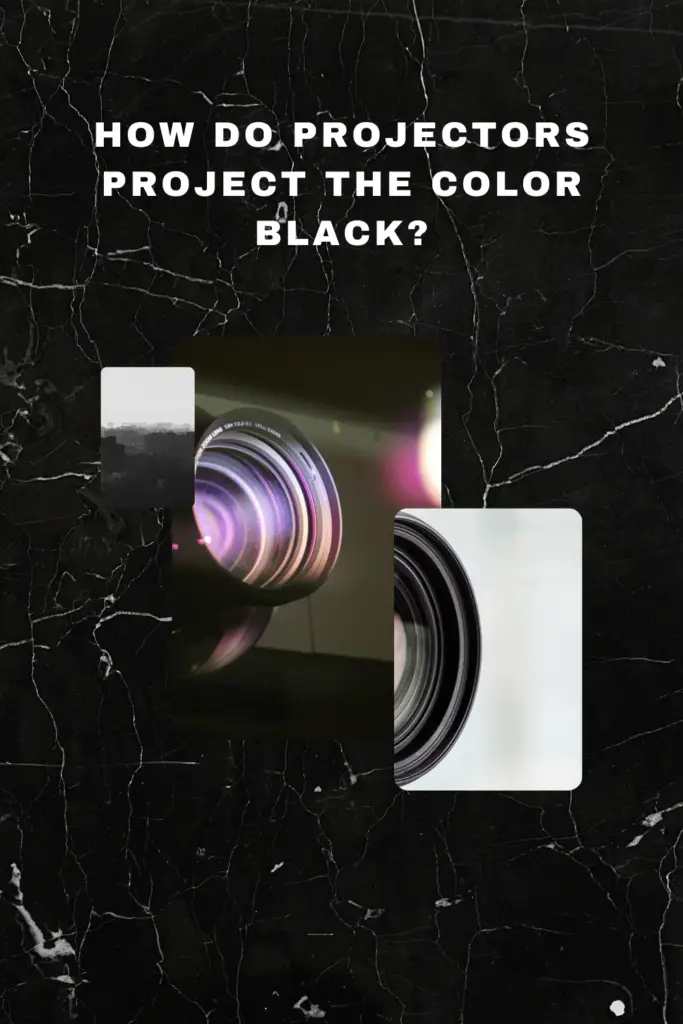In movies and TV, we often see black projected onto a white screen. But do you ever stop to think about how projectors create the color black? It’s actually a lot more complicated than you might think!
In this blog post, we’ll take a closer look at how projectors generate black color and some of the challenges involved in doing so.

Table of Contents
How Do We See Colors?
Our eyes are able to see colors because of the way that light interacts with the various tissues and structures within our eyes. Light is made up of tiny particles called photons, and when these photons strike an object, they bounce off in all directions.
Some of these photons then enter our eyes, and they are focused by the lens onto the retina, a layer of light-sensitive cells at the back of the eye. Different wavelengths of light correspond to different colors, and each type of cell in the retina is most sensitive to a specific wavelength.
As a result, when light hits the retina, different cells are activated and send signals to the brain telling us what color we are seeing. In other words, color is nothing more than our brain’s interpretation of the different types of light that we see.
How do Projectors project the color black?
Most projectors create color by combining red, green, and blue light (RGB) and projecting it onto a screen. When all three colors are combined at full strength, the result is pure white light. By adjusting the intensity of each color, different shades can be created. Black, on the other hand, is created by the Absence of light.
When no light is projected onto the screen, the result is darkness. However, in order to create a true black image, most projectors use what is known as an “infinite contrast” mode. In this mode, the projector’s iris is closed down to its smallest opening. This allows for less light to reach the screen, resulting in a darker image.
While this method can create a fairly dark image, it is not truly black. To achieve true blackness, many high-end projectors use an LED light source instead of traditional RGB bulbs. LED lights can be turned off completely, resulting in true darkness when projected onto a screen.
Why Surface is essential for projectors to produce Black Color
A projector produces an image by shining a light through a small opening and onto a surface. The size of the opening, the type of light source, and the surface all play a role in the quality of the image. One of the most important factors is the surface.
A matte black surface helps to absorb light, which is essential for producing deep black tones. In contrast, a glossy white surface reflects light, resulting in a brighter image with less defined shadows.
For this reason, many projection screens are made from materials that have been specifically designed to produce deep blacks. By choosing the right surface, you can ensure that your projector produces high-quality images with rich detail and deep blacks.
Dark Projector Screen VS. White Projector Screen
The main difference between dark and white projector screens is the level of contrast they provide. Dark screens have a higher level of contrast, which means they produce sharper images with more defined details. White screens, on the other hand, have a lower level of contrast.
This results in somewhat fuzzy images with less defined details. In general, dark screens are better for rooms with little to no ambient light, while white screens work best in rooms with more natural light. However, it’s ultimately up to the viewer to decide which type of screen produces the best image quality.
Challenges faced by Projectors to Produce Black color
One of the common issues that projectors face is related to the production of black color. Due to the nature of light, it is difficult for projectors to produce a true black. As a result, images can often appear washed out, with poor contrast and details.
To combat this issue, some projector manufacturers have developed technologies that allow them to produce darker shades of black. However, these solutions often come at the expense of image brightness and clarity. As such, achieving a perfect balance between black level and image quality can be a challenge for projector makers.
FAQ – Projector and Black Color
1. How To Make The Projector Dark?
There are a few ways to make the projector dark. One way is to adjust the shade on the front of the projector. By turning the knob clockwise, the shade will get smaller and block more light. Another way to darken the projector is to use a remote control.
If your projector has a remote, there should be a button that says “shade.” By pressing this button, the shade will automatically adjust to make the projector darker. Finally, you can also use a piece of black tape over the lens of the projector. This will completely block the light and make the screen appear black. Depending on your needs, one of these methods should help you to make the projector dark.
2. What Is The Best Color Screen For A Projector?
When choosing a projector, one of the most important considerations is the type of screen. The three most common choices are white, grey, and black. Each has its own advantages and disadvantages.
White screens reflect more light, making them ideal for rooms with high ambient light levels. Grey screens offer a middle ground between white and black, providing good contrast without creating too much glare.
Black screens have the best contrast ratio, but they can be difficult to see in rooms with high ambient light levels. Ultimately, the best screen color for a projector depends on the specific needs of the user.
3. What should I do to get a better quality image with my projector?
There are a few things you can do to get a better quality image with your projector.
First, make sure that the projector is properly positioned. The image will be clearer if the projector is perpendicular to the screen.
Second, adjust the focus until the image is as sharp as possible.
Third, try to reduce the amount of ambient light in the room.
Fourth, clean the lens of the projector regularly.
Finally, if you are using an older model projector, consider upgrading to a newer one. Newer models usually have better resolution and contrast, which will result in a clearer image. By following these tips, you should be able to get a high-quality image with your projector.
Final Note
Projectors are a great way to share images and videos with a group of people, but they can sometimes be challenging to use. One of the common issues that projectors face is related to the production of black color. This can often result in washed out images with poor contrast and details.

